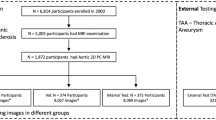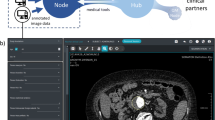Abstract
Machine learning (ML) and deep learning (DL) algorithms have recently gained traction in the field of aortic imaging for their potential to provide novel insights and to standardize the extraction of imaging features while delivering accurate and reproducible results. With DL algorithms, it is now possible to model complex relationships within vast imaging and clinical datasets. In this chapter, we highlighted the most recent ML and DL applications in image segmentation, image classification, and outcome prediction of patients with aortic dissection and abdominal aortic aneurysm.
Access this chapter
Tax calculation will be finalised at checkout
Purchases are for personal use only
Similar content being viewed by others
References
Nienaber CA, Clough RE, Sakalihasan N, Suzuki T, Gibbs R, Mussa F, Jenkins MP, Thompson MM, Evangelista A, Yeh JS, Cheshire N, Rosendahl U, Pepper J. Aortic dissection. Nat Rev Dis Primers. 2016;2:16053. https://doi.org/10.1038/nrdp.2016.53.
Codari M, Pepe A, Mistelbauer G, Mastrodicasa D, Walters S, Willemink MJ, Fleischmann D. Deep reinforcement learning for localization of the aortic annulus in patients with aortic dissection. In: Thoracic image analysis. Cham: Springer International Publishing; 2020. p. 94–105.
Hahn LD, Mistelbauer G, Higashigaito K, Koci M, Willemink MJ, Sailer AM, Fischbein M, Fleischmann D. CT-based true- and false-lumen segmentation in type B aortic dissection using machine learning. Radiol Cardiothora Imaging. 2020;2(3):e190179. https://doi.org/10.1148/ryct.2020190179.
Lopez-Linares K, Aranjuelo N, Kabongo L, Maclair G, Lete N, Ceresa M, Garcia-Familiar A, Macia I, Gonzalez Ballester MA. Fully automatic detection and segmentation of abdominal aortic thrombus in post-operative CTA images using deep convolutional neural networks. Med Image Anal. 2018;46:202–14. https://doi.org/10.1016/j.media.2018.03.010.
Wojnarski CM, Svensson LG, Roselli EE, Idrees JJ, Lowry AM, Ehrlinger J, Pettersson GB, Gillinov AM, Johnston DR, Soltesz EG, Navia JL, Hammer DF, Griffin B, Thamilarasan M, Kalahasti V, Sabik JF 3rd, Blackstone EH, Lytle BW. Aortic dissection in patients with bicuspid aortic valve-associated aneurysms. Ann Thorac Surg. 2015;100(5):1666–73. https://doi.org/10.1016/j.athoracsur.2015.04.126; discussion 1673-1664.
Hadjianastassiou VG, Franco L, Jerez JM, Evangelou IE, Goldhill DR, Tekkis PP, Hands LJ. Informed prognosis [corrected] after abdominal aortic aneurysm repair using predictive modeling techniques [corrected]. J Vasc Surg. 2006;43(3):467–73. https://doi.org/10.1016/j.jvs.2005.11.022.
Zheng Y, John M, Liao R, Nottling A, Boese J, Kempfert J, Walther T, Brockmann G, Comaniciu D. Automatic aorta segmentation and valve landmark detection in C-arm CT for transcatheter aortic valve implantation. IEEE Trans Med Imaging. 2012;31(12):2307–21. https://doi.org/10.1109/TMI.2012.2216541.
Al WA, Jung HY, Yun ID, Jang Y, Park HB, Chang HJ. Automatic aortic valve landmark localization in coronary CT angiography using colonial walk. PLoS One. 2018;13(7):e0200317. https://doi.org/10.1371/journal.pone.0200317.
Ghesu FC, Georgescu B, Zheng Y, Grbic S, Maier A, Hornegger J, Comaniciu D. Multi-scale deep reinforcement learning for real-time 3D-landmark detection in CT scans. IEEE Trans Pattern Anal Mach Intell. 2019;41(1):176–89. https://doi.org/10.1109/TPAMI.2017.2782687.
Rueckel J, Reidler P, Fink N, Sperl J, Geyer T, Fabritius MP, Ricke J, Ingrisch M, Sabel BO. Artificial intelligence assistance improves reporting efficiency of thoracic aortic aneurysm CT follow-up. Eur J Radiol. 2021;134:109424. https://doi.org/10.1016/j.ejrad.2020.109424.
Abdullah Al W, Yun ID. Partial policy-based reinforcement learning for anatomical landmark localization in 3D medical images. IEEE Trans Med Imaging. 2020;39(4):1245–55. https://doi.org/10.1109/TMI.2019.2946345.
Alansary A, Oktay O, Li Y, Folgoc LL, Hou B, Vaillant G, Kamnitsas K, Vlontzos A, Glocker B, Kainz B, Rueckert D. Evaluating reinforcement learning agents for anatomical landmark detection. Med Image Anal. 2019;53:156–64. https://doi.org/10.1016/j.media.2019.02.007.
Astudillo P, Mortier P, Bosmans J, De Backer O, de Jaegere P, Iannaccone F, De Beule M, Dambre J. Automatic detection of the aortic annular plane and coronary ostia from multidetector computed tomography. J Interv Cardiol. 2020;2020:9843275. https://doi.org/10.1155/2020/9843275.
Noothout JMH, De Vos BD, Wolterink JM, Postma EM, Smeets PAM, Takx RAP, Leiner T, Viergever MA, Isgum I. Deep learning-based regression and classification for automatic landmark localization in medical images. IEEE Trans Med Imaging. 2020;39(12):4011–22. https://doi.org/10.1109/TMI.2020.3009002.
Noothout JM, De Vos BD, Wolterink JM, Išgum I. Automatic segmentation of thoracic aorta segments in low-dose chest CT. In: Medical Imaging 2018: Image Processing. International Society for Optics and Photonics; 2018. p. 105741S.
Aberle DR, Berg CD, Black WC, Church TR, Fagerstrom RM, Galen B, Gareen IF, Gatsonis C, Goldin J, Gohagan JK, Hillman B, Jaffe C, Kramer BS, Lynch D, Marcus PM, Schnall M, Sullivan DC, Sullivan D, Zylak CJ, National Lung Screening Trial Research T. The National Lung Screening Trial: overview and study design. Radiology. 2011;258(1):243–53. https://doi.org/10.1148/radiol.10091808.
Fantazzini A, Esposito M, Finotello A, Auricchio F, Pane B, Basso C, Spinella G, Conti M. 3D automatic segmentation of aortic computed tomography angiography combining multi-view 2D convolutional neural networks. Cardiovasc Eng Technol. 2020;11(5):576–86. https://doi.org/10.1007/s13239-020-00481-z.
Cao L, Shi R, Ge Y, Xing L, Zuo P, Jia Y, Liu J, He Y, Wang X, Luan S, Chai X, Guo W. Fully automatic segmentation of type B aortic dissection from CTA images enabled by deep learning. Eur J Radiol. 2019;121:108713. https://doi.org/10.1016/j.ejrad.2019.108713.
Cheng J, Tian S, Yu L, Ma X, Xing Y. A deep learning algorithm using contrast-enhanced computed tomography (CT) images for segmentation and rapid automatic detection of aortic dissection. Biomed Signal Processing Cont. 2020;62:102145. https://doi.org/10.1016/j.bspc.2020.102145.
Bai W, Suzuki H, Qin C, Tarroni G, Oktay O, Matthews PM, Rueckert D. Recurrent neural networks for aortic image sequence segmentation with sparse annotations. In: Medical image computing and computer assisted intervention – miccai 2018. Cham: Springer International Publishing; 2018. p. 586–94.
de Bruijne M, van Ginneken B, Viergever MA, Niessen WJ. Interactive segmentation of abdominal aortic aneurysms in CTA images. Med Image Anal. 2004;8(2):127–38. https://doi.org/10.1016/j.media.2004.01.001.
Subasic M, Loncaric S, Sorantin E. 3-D image analysis of abdominal aortic aneurysm. Stud Health Technol Inform. 2000;77:1195–200.
Zhuge F, Rubin GD, Sun S, Napel S. An abdominal aortic aneurysm segmentation method: level set with region and statistical information. Med Phys. 2006;33(5):1440–53. https://doi.org/10.1118/1.2193247.
Maiora J, Papakostas GA, Kaburlasos VG, Grana M. A proposal of texture features for interactive CTA segmentation by active learning. Stud Health Technol Inform. 2014;207:311–20.
Lalys F, Yan V, Kaladji A, Lucas A, Esneault S. Generic thrombus segmentation from pre- and post-operative CTA. Int J Comput Assist Radiol Surg. 2017;12(9):1501–10. https://doi.org/10.1007/s11548-017-1591-8.
Joldes GR, Miller K, Wittek A, Forsythe RO, Newby DE, Doyle BJ. BioPARR: a software system for estimating the rupture potential index for abdominal aortic aneurysms. Sci Rep. 2017;7(1):4641. https://doi.org/10.1038/s41598-017-04699-1.
Wang D, Zhang R, Zhu J, Teng Z, Huang Y, Spiga F, Hong-Fei Du M, Gillard JH, Lu Q, Lio P. Neural network fusion: a novel CT-MR aortic aneurysm image segmentation method. Proc SPIE Int Soc Opt Eng. 2018;10574 https://doi.org/10.1117/12.2293371.
Lareyre F, Adam C, Carrier M, Dommerc C, Mialhe C, Raffort J. A fully automated pipeline for mining abdominal aortic aneurysm using image segmentation. Sci Rep. 2019;9(1):13750. https://doi.org/10.1038/s41598-019-50251-8.
Harris RJ, Kim S, Lohr J, Towey S, Velichkovich Z, Kabachenko T, Driscoll I, Baker B. Classification of aortic dissection and rupture on post-contrast CT images using a convolutional neural network. J Digit Imaging. 2019;32(6):939–46. https://doi.org/10.1007/s10278-019-00281-5.
Hata A, Yanagawa M, Yamagata K, Suzuki Y, Kido S, Kawata A, Doi S, Yoshida Y, Miyata T, Tsubamoto M, Kikuchi N, Tomiyama N. Deep learning algorithm for detection of aortic dissection on non-contrast-enhanced CT. Eur Radiol. 2021;31(2):1151–9. https://doi.org/10.1007/s00330-020-07213-w.
Wu J, Qiu J, Xie E, Jiang W, Zhao R, Qiu J, Zafar MA, Huang Y, Yu C. Predicting in-hospital rupture of type a aortic dissection using random. Forest J Thorac Dis. 2019;11(11):4634–46. https://doi.org/10.21037/jtd.2019.10.82.
Macrina F, Puddu PE, Sciangula A, Trigilia F, Totaro M, Miraldi F, Toscano F, Cassese M, Toscano M. Artificial neural networks versus multiple logistic regression to predict 30-day mortality after operations for type a ascending aortic dissection. Open Cardiovasc Med J. 2009;3:81–95. https://doi.org/10.2174/1874192400903010081.
Macrina F, Puddu PE, Sciangula A, Totaro M, Trigilia F, Cassese M, Toscano M. Long-term mortality prediction after operations for type a ascending aortic dissection. J Cardiothorac Surg. 2010;5:42. https://doi.org/10.1186/1749-8090-5-42.
Lee R, Jarchi D, Perera R, Jones A, Cassimjee I, Handa A, Clifton DA, Oxford Abdominal Aortic Aneurysm Study A, Oxford Regional Vascular S. Applied machine learning for the prediction of growth of abdominal aortic aneurysm in humans. EJVES Short Rep. 2018;39:24–8. https://doi.org/10.1016/j.ejvssr.2018.03.004.
Kleinstreuer C, Li Z. Analysis and computer program for rupture-risk prediction of abdominal aortic aneurysms. Biomed Eng Online. 2006;5:19. https://doi.org/10.1186/1475-925X-5-19.
Wise ES, Hocking KM, Brophy CM. Prediction of in-hospital mortality after ruptured abdominal aortic aneurysm repair using an artificial neural network. J Vasc Surg. 2015;62(1):8–15. https://doi.org/10.1016/j.jvs.2015.02.038.
Monsalve-Torra A, Ruiz-Fernandez D, Marin-Alonso O, Soriano-Paya A, Camacho-Mackenzie J, Carreno-Jaimes M. Using machine learning methods for predicting inhospital mortality in patients undergoing open repair of abdominal aortic aneurysm. J Biomed Inform. 2016;62:195–201. https://doi.org/10.1016/j.jbi.2016.07.007.
Turton EP, Scott DJ, Delbridge M, Snowden S, Kester RC. Ruptured abdominal aortic aneurysm: a novel method of outcome prediction using neural network technology. Eur J Vasc Endovasc Surg. 2000;19(2):184–9. https://doi.org/10.1053/ejvs.1999.0974.
Karthikesalingam A, Attallah O, Ma X, Bahia SS, Thompson L, Vidal-Diez A, Choke EC, Bown MJ, Sayers RD, Thompson MM, Holt PJ. An artificial neural network stratifies the risks of Reintervention and mortality after endovascular aneurysm repair; a retrospective observational study. PLoS One. 2015;10(7):e0129024. https://doi.org/10.1371/journal.pone.0129024.
Attallah O, Karthikesalingam A, Holt PJ, Thompson MM, Sayers R, Bown MJ, Choke EC, Ma X. Using multiple classifiers for predicting the risk of endovascular aortic aneurysm repair re-intervention through hybrid feature selection. Proc Inst Mech Eng H. 2017;231(11):1048–63. https://doi.org/10.1177/0954411917731592.
Attallah O, Karthikesalingam A, Holt PJE, Thompson MM, Sayers R, Bown MJ, Choke EC, Ma X. Feature selection through validation and un-censoring of endovascular repair survival data for predicting the risk of re-intervention. BMC Med Inform Decis Mak. 2017;17(1):115. https://doi.org/10.1186/s12911-017-0508-3.
Garcia G, Maiora J, Tapia A, De Blas M. Evaluation of texture for classification of abdominal aortic aneurysm after endovascular repair. J Digit Imaging. 2012;25(3):369–76. https://doi.org/10.1007/s10278-011-9417-7.
Perrin D, Badel P, Orgeas L, Geindreau C, Dumenil A, Albertini JN, Avril S. Patient-specific numerical simulation of stent-graft deployment: validation on three clinical cases. J Biomech. 2015;48(10):1868–75. https://doi.org/10.1016/j.jbiomech.2015.04.031.
Author information
Authors and Affiliations
Corresponding author
Editor information
Editors and Affiliations
Rights and permissions
Copyright information
© 2022 The Author(s), under exclusive license to Springer Nature Switzerland AG
About this chapter
Cite this chapter
Mastrodicasa, D. et al. (2022). Artificial Intelligence-Based Evaluation of the Aorta. In: De Cecco, C.N., van Assen, M., Leiner, T. (eds) Artificial Intelligence in Cardiothoracic Imaging. Contemporary Medical Imaging. Humana, Cham. https://doi.org/10.1007/978-3-030-92087-6_47
Download citation
DOI: https://doi.org/10.1007/978-3-030-92087-6_47
Published:
Publisher Name: Humana, Cham
Print ISBN: 978-3-030-92086-9
Online ISBN: 978-3-030-92087-6
eBook Packages: MedicineMedicine (R0)




